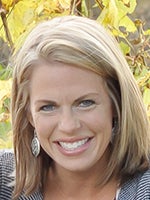Guest Column: Seasonal affective disorder happens in winter
Published 9:00 am Sunday, December 11, 2016
Live United by Ariel Winter
You may have heard of “winter blues” but did you know that this is an actual condition called seasonal affective disorder? Seasonal affective disorder, or SAD, is when a person experiences depressive symptoms exclusively during the winter months.
Seasonal affective disorder is a subtype of major depression. A person will experience the typical symptoms of major depression, such as feeling depressed most days, low energy and feelings of hopelessness. However, with SAD, there are also additional symptoms that can be experienced, such as appetite changes, especially cravings for high carbohydrate foods, low energy, irritability and weight gain.

Ariel Winter
Although the cause of seasonal affective disorder is not fully understood, it is thought to be related to our circadian rhythms being affected due to the limited exposure of sunlight during the winter months. Our bodies end up with too much melatonin which makes us sleepy and not enough serotonin which makes us unhappy.
The silver lining is that we do not need to simply endure these symptoms, but can utilize tools to continue to live life to our fullest during our darker days. There are several modes of treatment for seasonal affective disorder. Traditional modes of treatment include psychotherapy, medication and light therapy.
Light therapy is when an individual sits or works near what is called a light therapy box. The light box gives off bright light that mimics natural sunlight. The process is typically done in the morning to help set one’s circadian rhythm for the day.
A person can utilize light therapy as their sole mode of treatment or in conjunction with other therapies depending on severity of symptoms. A prescription is not needed for a light box. However, consult with your doctor regarding the frequency of its use, as it may cause hypomania symptoms in those with bipolar disorder.
In order to experience its therapeutic effects, the light box needs to emit at least 10,000 lux. Light therapy is very common in the Scandinavian countries that also experience limited amounts of sunlight in the winter months.
Another strategy to combat winter depression is getting enough Vitamin D. It is also known as the sunshine vitamin. On average, a person needs sun exposure for 10 to 15 minutes per day to produce enough Vitamin D. During our frigid Minnesota winters, we are not exposed to adequate amounts of natural sunlight. This makes it difficult for our bodies to produce Vitamin D. People who experience SAD often take vitamin D supplements to help alleviate their depressive symptoms.
Other alternative therapies beneficial in alleviating depressive symptoms include yoga and meditation. Although these modalities do not require a prescription, research has indicated that meditation can be as or more effective as anti-depressants in curbing symptoms of depression. Yoga and meditation are very affordable with little to no side effects. However, be sure to consult with your doctor before making changes to your medications.
It is important to remember to ask for help if you’re experiencing seasonal affective disorder or other forms of depression. Asking for help takes great strength, and it is not a sign of weakness. It is important that we don’t feel alone in our struggles and know that we can support one another in our trials.
Know that when you are feeling better and your symptoms begin to lift, you can pay it forward to someone else along the way. Sometimes it can be challenging to see if symptoms are improving despite treatment efforts. Journaling symptoms along with treatment tools used can help us see correlations keeping those tools that helped along the way. It may take a winter or two to find what works, but soon enough you will find what works for you.
Ariel Winter is the lead adult mental health case manager for Freeborn County and serves on the Community Mental Health Committee.

